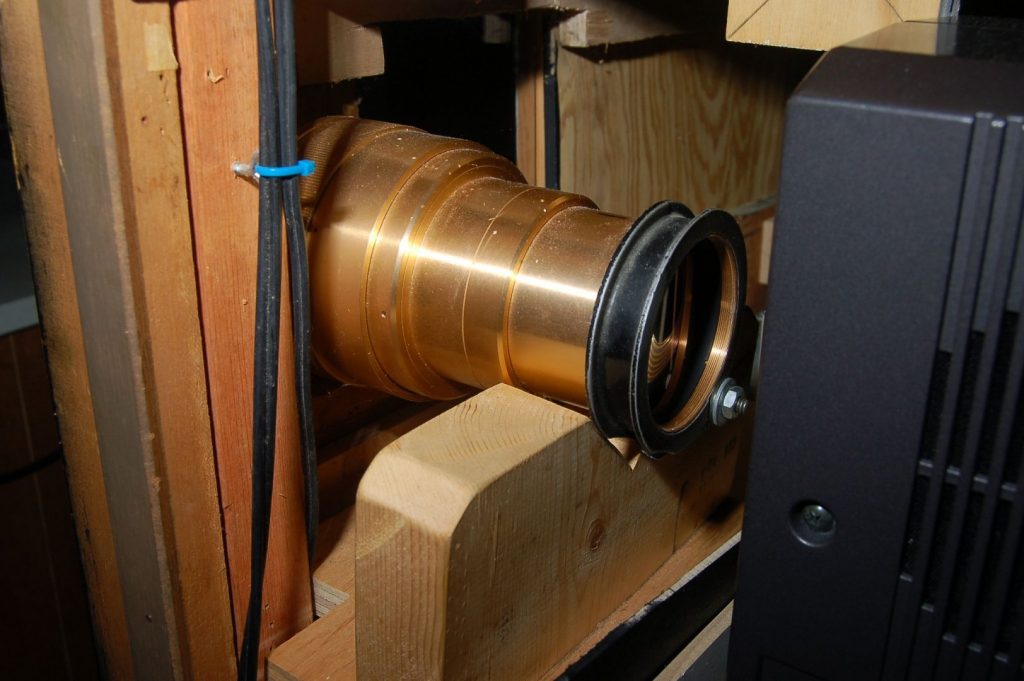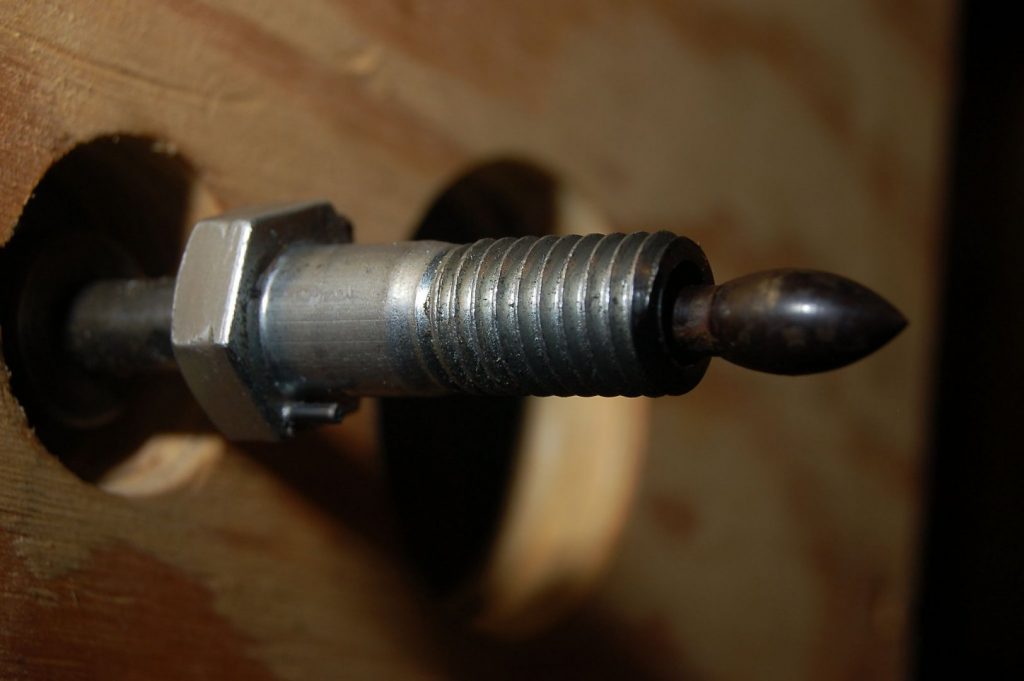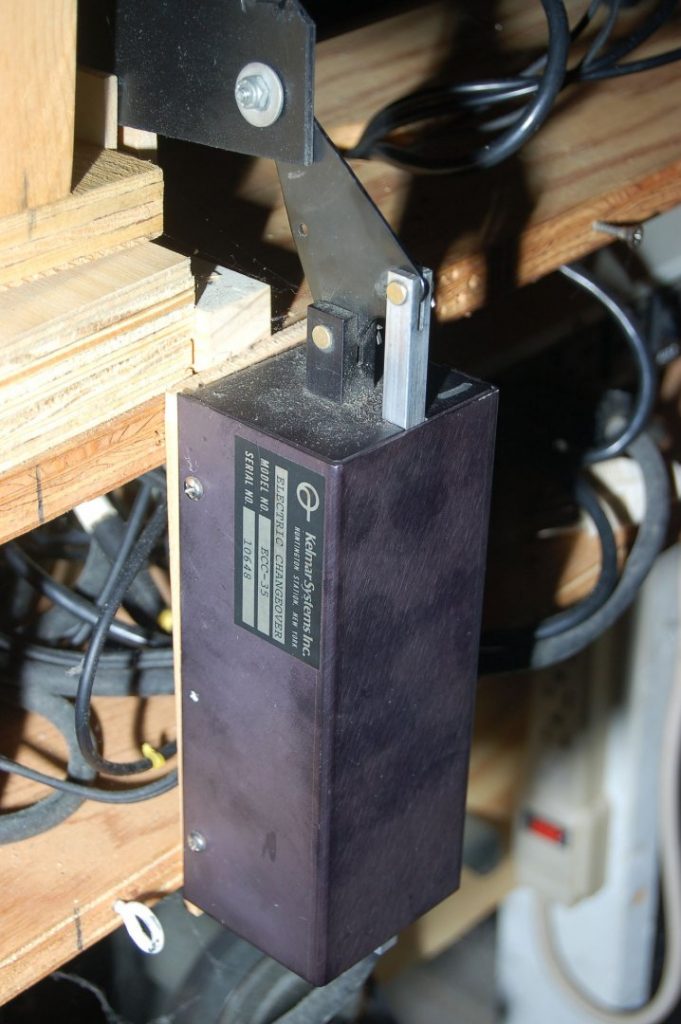If you have a story to tell then send it to my email, and a photo or two would be nice.
This chapter features Chip Gelmini, a collector from the USA.
Chip Gelmini
It was 1963 and I was introduced to the Argus Showmaster 500 movie projector. My Dad unwound a few feet of white plastic film and began to thread manual into the film path. When he turned it on, I was amazed how the sprocket wheels pulled it in and out, and the gate loops bounced up and down all in perfect harmony. The mechanics of this seemed more interesting to me than the family gatherings being shown on the tripod screen 12 feet away. The very idea that small spool could hold hundreds of separate images – each one uniquely different – and move them at lightning speed was surreal to me. But heck, I was only 3 years old, but I knew back then it would need more investigating.
By the time I was 8, I was hand cranking cassette cartoons through my Kenner Easy Show Projector. Easy to thread, and worked on the basis of a flash light – there I was in the downstairs hallway projecting on to a closed bedroom door.
In 4th grade we did well on a reading assignment, and the school brought in a feature print of a Disney movie. I don’t know for sure – but I remember something called HANG YOUR HAT ON THE WIND. That was either the title or a song in the movie. This opened up a whole new world for me. Movies, slight wider in format (16mm) and it had sound. And those giant 1600 foot reels! Oh my!
But it was a summer trip to the drive in. I went with Dad to the snack bar, and as we returned to the car we stopped at the projection booth. My Dad was actually interested…not me. But, now the film was even wider (35mm) it also had sound, and the reels were bigger (2000ft) and spinning so fast at start up. I was probably 11 or 12. Well that changed everything. In high school I joined the A/V club, and began wheeling projectors throughout the classrooms for film days. I later would start training in theaters for a 35+ year career in cinemas and drive ins running the analog 35mm.
But through it all, I never gave up on the 8mm. In 1972 I was introduced to super 8 black and white silent digests and quickly acquired many of them. The strange thing was, they looked like it was running too slow. If the character walked across the screen, it appeared it was slower than normal speed. I soon realized the digest was taken from a sound print, running at 24 frames per second, and I was running the digest through a silent machine at 18fps.
In 1978 I had my first super 8 sound film, the Ken digest of Star Wars a New Hope. And along with it, my first sound projector a Bell & Howell 1733BZ. I was on my way off to a flying start warp drive never looking back. Now I own over 425 features on super 8. I also have about 14 on 16mm. I’m also a dedicated GS1200 collector and LOVE this machine. Takes a while to get one serviced properly but once you do it is a workhorse of a machine that you can depend on.
I still to this day don’t look or hold back. Always collecting films and equipment. For the rest of my life…… Chip Gelmini
It was 1978 a busy year for new movies. Grease had smashed all-time records in June. Animal House followed later that summer. And among others, Superman the Movie closed out the year in December. I was fortunate enough to have my foot through the door as a rookie projectionist. I took shifts when and where I could.
Superman was in a beautiful single screen theater with up to date 35mm projection. The 6000 foot reels seemed enormous to me. The one changeover for the average movie (Superman was 2) was just a single. Reels 123 on big reel 1 and reels 456 on big reel 2.
As I sat waiting to do my work, I started to think how cool it would be to use 35mm equipment to actually run the smaller film gauges at home. I had the thought of approaching Century Projector Corporation with the idea of producing a manual threading super 8 machine based on their 35mm SA model picture and sound head combination, along with all the bells and whistles. Which would have included removable gate for easy cleaning, aperture plates for full flat vs widescreen or scope, electric changeovers, and big reels. But soon I realized that mission would be impossible. Not enough money to guarantee sales for profit and so on.
So then I decided to tackle that same idea with a different twist. Obtain what I could over time, and make it work. The goal would be to produce very professionally run shows at home, working just as a projectionist in a theater would have done.
The idea worked. Luck was on my side. As I stayed employed, technology was changing. Older movie houses were left for demolition as newer multiplexes were about to open. Equipment left behind for the dump – I was able to grab for free. Just do the labor to remove it. And all with permission. Management arranged for me to be in the building just to avoid the police becoming involved.
Over the next few years I grabbed scope lenses, upper and lower projector reel arms, rewind benches complete with motors, platter motors, speed controls, penthouse film cleaners, lens cleaning supplies, and so on. I even got an authentic movie screen with thousands of tiny pin holes so I could place my speaker behind it allowing the sound to come through!
I designed my own projection Tower. Almost the size of a 35mm projector made with exact pieces that I had grabbed. I placed a projector in the middle. The film came from the top reel through the machine and down to the bottom reel. A speed control and platter motor, along with a bottom projector take up clutch easily gave it 10 percent power equal to super 8 pay out. Adjustment of tension spring on the backside of the clutch made it possible, too.
So here I am today running movies after all this time. A record 45 years with super 8 sound, some 16, and along with it 35 years in the 35mm projection booth. I had retired just as analog was being phased out and digital was coming in.
Despite everything my career ended just the way it began. I started on Carbon Arcs changing over every 20 minutes. It ended the same way at a local art house cinema that still used the 2000 foot reels, although the carbons had been replaced by Xenon bulb. It was a nice way to end the career just as it had started – at a cinema rich in history.
And now I have my Towers. The front room has Dolby surround. And a spare bedroom at the back of the house is now the outdoor projection booth. A tarp screen is hung on studs in the backyard one night a week from November 1st through middle of May. Neighbors come in for a free show. Inside the bedroom booth is another pair of Towers.
I have never been enjoying super 8 and 16mm as I am now.
I designed, built, and am living my dream theater.
A shout out to Mr. Jones: Thank you for asking me to write my story for your Derann page! CHIP GELMINI
Illustrations: 1: Rewind bench with Neumade X3 cranks and the optional motor pulley with belt.
2: Isco Optics 2X scope lens in a cradle being used for super 8.
3: Custom made threaded super 8 adapter clamped on a 5/16 assembly for 35mm projector.
4: Part of electric changeover shutter system.
5: Authentic movie screen with sound penetration holes. Ugly speaker boxes can be hidden.








Leave a Reply